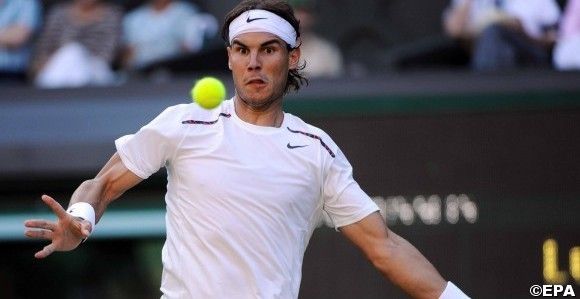Today’s Men’s Feature (12/19)
Strong Medicine
Last time, in women’s news, we asked the question, “So — were the Slams really the biggest events of 2012?”
The question is obviously just as relevant to the men as to the women. And so we’ll look at the question in the same way. We will simplify it a little, though. We’ll use the same method Top Four Players-based method we used for the women — but, this time, we’ll express the result as a percent. An event which features all four of the Top Four will be rated at 100% of the maximum possible strength. Take out the #4 player and replace him with #5, as was the case for most of the second half of 2012 due to Rafael Nadal’s injury, turns out to produce an event at 93% of maximum strength. An event with the #3 player lacking is at 87%. An event with #10, #20, #30, and #40 as the top four players would be at 10% of maximum strength. The list below gives all the events, sorted in descending order of strength. The number in parentheses is the points awarded to the winner.
1. Australian Open (2000): 100%
1. Indian Wells (1000): 100%
1. Miami (1000): 100%
1. Rome (1000): 100%
1. Roland Garros (2000): 100%
1. Wimbledon (2000): 100%
7. Madrid (1000): 93%
7. London (1500): 93%
9. Monte Carlo (1000): 87%
9. Olympics (750): 87%
9. Cincinnati (1000): 87%
9. U. S. Open (2000): 87%
9. Shanghai (1000): 87%
14. Dubai (500): 76%
15. Paris (1000): 62%
16. Canadian Open (1000): 52%
17. Barcelona (500): 50%
18. Doha (250): 41%
19. Beijing (500): 38%
20. Halle (250): 35%
20. Tokyo (500): 35%
22. Queen’s (250): 33%
23. Valencia (500): 30%
24. Rotterdam (500): 29%
25. Marseille (250): 28%
26. Basel (500): 27%
27. Brisbane (250): 26%
28. Winston-Salem (250): 25%
29. Buenos Aires (250): 21%
30. Stockholm (250): 20%
31. Montpellier (250): 20%
31. Acapulco (500): 20%
33. Houston (250): 19%
33. Kuala Lumpur (250): 19%
35. Nice (250): 18%
35. Hamburg (500): 18%
37. Bangkok (250): 16%
38. Auckland (250): 16%
39. Chennai (250): 15%
40. Vienna (250): 14%
41. Sydney (250): 14%
42. Atlanta (250): 14%
43. Munich (250): 13%
43. Metz (250): 13%
45. Delray Beach (250): 13%
46. Umag (250): 12%
47. Gstaad (250): 12%
48. Sao Paulo (250): 12%
49. Bastad (250): 11%
49. Newport (250): 11%
51. Stuttgart (250): 11%
52. Estoril (250): 10%
53. Memphis (500): 9%
53. Bucharest (250): 9%
53. Eastbourne (250): 9%
56. Washington (250): 9%
57. s-Hertogenbosch (250): 8%
58. San Jose (250): 8%
59. Moscow (250): 8%
60. Casablanca (250): 8%
61. Kitzbuhel (250): 7%
62. Vina del Mar (250): 7%
63. Zagreb (250): 6%
64. St. Petersburg (250): 6%
65. Belgrade (250): 5%
66. Los Angeles (250): 4%
The system, it is clear, is working pretty well: There are seven events with all of the Top Four, and all of them were required. There were thirteen events which achieved at least 80% of full strength, and all but two were required, the two exceptions being Monte Carlo (which had as many points as a required event) and the Olympics (which was, well, the Olympics). All of the Slams reached at least 80% strength. If the U. S. Open and London weren’t among the very strongest events, that’s because Nadal was injured; everyone else was there.
We did not quite find that all the required events were stronger than all the optionals. Note that Dubai, a 500 point event, was stronger than two Masters, Paris and the Canadian Open. Still, fifteen of the top sixteen places were occupied by events worth at least 750 points, and no required event was below #16 on the list.
Dubai was the strongest optional event, followed by Barcelona, both 500 point events. It is fascinating to see that Doha, a 250, is the next-strongest, ahead of most of the 500 pointers. Obviously appearance fees can have their effects.
We do see one 500 point event (Memphis) very far down the list at #53. But the last thirteen events on the list are all 250s — including Los Angeles, which has lost its license. The numbers may show why. And, other than Memphis, every 500 point event is #35 in the list or higher. In other words, 30 of the 31 weakest events are 250s.
So the ATP events tiers correlate pretty well with the event strengths. Plus it all corresponds pretty well with the ATP ranking system. Of the eight strongest events, Djokovic won three (Australian Open, Miami, London), Federer won three (Indian Wells, Wimbledon, Madrid), and Nadal won two (Rome, Roland Garros). Andy Murray, interestingly, was shut out; his best win was at the Olympics, tied for #9 on the list. The strongest event not won by one of the Big Four was #15 Paris, won by Ferrer. The next-strongest was #18 Doha, won by Tsonga, then #20 Halle, won by Haas. To put it another way, the Big Four won seventeen of the Top Twenty events. No wonder it’s hard for the other players to move up!


10sBalls Top Stories
- Bahis Sitelerinin Deneme Bonusu Kullanım Şartları
- Deneme Bonusları ile Ücretsiz Bahis Nasıl Yapılır?
- Cazip Hoş Geldin Bonusları ile Üyelik Avantajları
- Bahis Siteleri ve İlk Üyelik Bonusu Detayları
- Yeni Üyeler İçin En Cazip Bahis Bonusu
- Deneme Bonusları İle Eğlenceli Oyun Deneyimleri
- Güvenilir Bahis Siteleri: Bonus ve Güvenlik İncelemesi
- Reasons Behind the Increase in Sex Shops
- Reasons Behind the Increase in Sex Shops
- Reasons Behind the Increase in Sex Shops
- Casibom: Yaşayan Casinolar ve Bahisler Lider Platform
- Sea Star Casino: Play Games Without Registering Online
- JETZT DEN SWEET BONANZA SLOT GRATIS DREHEN
- Азартные игры с Мостбет Казино – испытайте удачу
- Çevrimiçi en iyi yuvalar: Hizmetinizde Karavan Bet Casino





 Today's Men's Feature (12/19)
Today's Men's Feature (12/19)